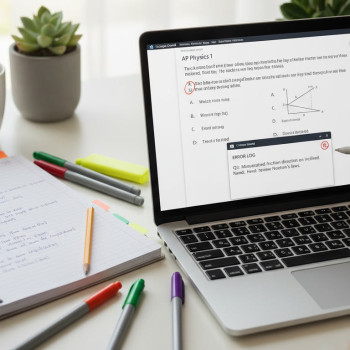Why “Use the Source” Beats “Summarize the Source” Every Time
If you’ve taken practice SAQs, you already know the trap: you read a primary source, your brain fills with interesting facts, and you end up paraphrasing the passage back to the reader. It feels safe—after all, you’re showing you read the source. But on the AP World History SAQ, the graders are looking for something sharper: evidence applied. They want you to do something with the source, not simply repeat what it says.

The difference in plain terms
Summarizing is restating what the source says. Using the source means connecting that information to the question: explaining how the source supports a claim, what the author’s perspective reveals about the historical moment, or how the document’s content fits into a broader trend or comparison. In short: summarizing shows reading; using shows thinking.
What the College Board Actually Wants from Your SAQ
The rubrics used for AP World History SAQs reward historical thinking skills—contextualization when required, direct use of source content, synthesis when appropriate, and clear, targeted answers. You don’t need a five-paragraph essay. You need a tight answer: claim, evidence from the source, and a brief explanation that ties the evidence to the claim.
Core elements of a high-scoring SAQ
- Directly answers the question posed (don’t drift).
- Uses specific evidence from the provided source(s).
- Explains the connection between evidence and claim—don’t assume it’s obvious.
- When required, includes additional outside knowledge or a short comparative or contextual statement.
- Is concise and well-organized—clarity beats quantity.
Step-by-Step: How to Attack an SAQ in Exam Conditions
Time is your enemy and your ally. You don’t need to craft a masterpiece—just the most effective use of the minute or two you have. Here’s a reliable routine you can practice until it becomes reflexive.
1. Read the question first (10–20 seconds)
Know what the question asks—cause, effect, comparison, or interpretation—before you read the source. Circle key command words: “Explain,” “Describe,” “Analyze,” “Compare.” That focus tells your brain where to look in the source.
2. Read the source with purpose (30–45 seconds)
Annotate fast: who wrote it, when, where, and what is the main claim or fact? Identify 1–2 phrases that will become your evidence. Resist the urge to rewrite entire sentences from the passage—capture the kernel you’ll use.
3. Build a one-sentence claim (10–15 seconds)
Answer the question directly in one clean sentence. This is your thesis for the SAQ. Don’t lead with context unless the question asks for it.
4. Use the source as evidence (20–40 seconds)
Pick the strongest snippet—either a factual statement, an opinion, or a detail in the source—and quote or paraphrase it briefly (2–15 words or a short clause). Immediately explain how that snippet supports your claim.
5. Add a short outside link or context if required (optional, 15–20 seconds)
Only add outside information if the prompt explicitly expects it or if it strengthens your explanation. Keep it tight—one concrete fact or example is enough.
Concrete Examples: Turning Sources into Answers
Examples turn theory into practice. Below are short mock prompts and model responses that show the “use the source” technique. Notice the economy—each answer is focused and tied to the document.
Prompt Example 1
Source: A quotation from an early 20th-century industrialist boasting about increased production.
Question: Explain one economic factor that contributed to the development described in the source.
Model Answer: One economic factor was the expansion of mechanized manufacturing, which increased output and lowered unit costs. The source’s claim that production volume grew due to newer machinery demonstrates how factories adopted mechanized processes; by reducing labor time per unit, firms could scale production and capture larger markets, fueling the development described in the quotation.
Why this works
The student used a specific idea from the source (production growth tied to machinery) as direct evidence and then explained the causal mechanism. They did not recite the whole passage.
Prompt Example 2
Source: A colonial official’s report complaining about local resistance to taxation.
Question: Explain one reason for resistance described in the source.
Model Answer: One reason for the resistance was the imposition of unfamiliar or burdensome taxes that disrupted local economic practices. The official’s complaint that villagers refused to pay indicates the tax’s perceived injustice or impracticality; when taxes clash with established livelihood patterns or seem to benefit external authorities more than locals, resistance often follows, as the source illustrates.
Why this works
The student pulls the complaint from the source and interprets it as evidence of perceived injustice—then connects it to a general cause of resistance. Short, specific, and relevant.
Common Mistakes and How to Avoid Them
- Rewriting the entire source: graders penalize wasted words. Use only what you need.
- Failing to tie evidence to the claim: every piece of evidence must be explained.
- Adding long unfocused context: a quick contextual phrase is okay; a paragraph is not.
- Ignoring command words: if it asks for a comparison, you must compare.
- Being vague: replace weak words like “things” or “big changes” with specific terms from the source or course themes.
Quick Scoring Checklist (Use this Before You Submit)
| Item | Why It Matters | Example |
|---|---|---|
| Direct answer to the prompt | Keeps your response on task | “One reason was…” |
| Uses specific source evidence | Shows you engaged with the document | Short quoted phrase or precise paraphrase |
| Explains connection | Demonstrates historical reasoning | “This shows…because…” |
| Optional: brief outside info | Strengthens answer when required | One concrete fact or date |
| Concise and readable | Make every word count | Clear sentences, no filler |
Timing Practice You Can Do This Weekend
You don’t need fancy prep to get faster and sharper—repeat, refine, and reflect. Use a timer and follow this practice loop:
- Pick 5 SAQs from past free-response sets or practice packets.
- Time yourself: 2–3 minutes per question; read the prompt first.
- After each answer, annotate where you used the source and how you explained it.
- Review with a partner or tutor and ask: Did I explicitly connect evidence to the claim?
How a tutor can speed this progress
A good tutor helps you spot weak explanations and teaches you tighter phrasing. Sparkl’s personalized tutoring offers 1-on-1 guidance and tailored study plans that can zero in on SAQ weaknesses—whether that’s evidence selection, thematic phrasing, or time management. A targeted session can turn a common mistake into a reliable strategy.
Beyond the SAQ: Building Habits that Feed Better Answers
Good SAQ responses come from a broader set of skills: reading primary sources critically, building historical arguments, and practicing economy of expression. Cultivate these habits:
Daily micro-practices
- Annotate one primary source a day in two minutes—mark the author, audience, purpose, and one specific line you’d use as evidence.
- Write a one-sentence explanation linking that line to a broader historical theme (labor change, imperialism, state-building, etc.).
- Practice transforming a summary sentence into an explanation sentence. For example, change “The source says X” into “The source shows X because Y.”
Weekly rhythm
Once a week, simulate a 15–20 minute GR (short set) where you do five SAQs, check against a scoring checklist, and schedule one weakness to work on that week (e.g., phrasing evidence, or adding relevant outside information).
Real-World Context: Why Using Sources Matters Beyond the Exam
Using the source is a skill historians use daily. You’re not just preparing for a test; you’re learning how to weigh evidence, extract meaning, and use documents to support claims. Those exact skills appear in college writing, research projects, and even real-world decision-making—when data must be interpreted, not merely reported.
Example: A historian’s workflow vs. an SAQ
- Historian reads a letter (source) → formulates a question → uses passage to support a thesis → connects to broader literature. SAQ: same flow, compressed into two minutes.
Answer Templates You Can Customize
Templates are not scripts; they are scaffolds that keep your answers focused. Use them until you internalize the moves.
Cause or Effect Template
“One cause/effect was [claim]. The source states that ‘[short evidence],’ which shows/explains that [explain the connection]. This led to [brief consequence or broader implication].”
Comparison Template
“Both sources/regions show [shared claim], as seen when [source detail]. However, [difference], which indicates [analysis].”
Sample Practice Set and Model Responses
Here’s a compact practice trio you can run through quickly. Time yourself and then check your answers against the model responses that follow.
Practice Prompt A (Document-Based)
Source: An agricultural census reporting increased cotton yields in the 19th century.
Question: Explain one technological or economic factor that contributed to the increase in yields.
Model Response: One technological factor was the adoption of improved seed varieties and mechanized tools. The census’s record of higher yields indicates that farmers used more productive seeds or equipment; improved inputs increase per-acre output by making planting and harvesting more efficient, which directly accounts for the yield increase reported in the source.
Practice Prompt B (Interpretive)
Source: A political cartoon showing tensions between metropolitan elites and colonial protesters.
Question: Explain one reason for the depicted tension.
Model Response: One reason was competing claims over political representation and rights. The cartoon’s depiction of elite figures and protesting crowds suggests elites’ unwillingness to share power; when political inclusion is blocked, protest is a likely response, which explains the confrontational scene the cartoonist drew.
Practice Prompt C (Comparison)
Source: Two short excerpts—one from a merchant’s letter about expanding trade routes, another from a regional leader’s decree promoting local industry.
Question: Briefly explain one similarity in economic goals expressed in the two sources.
Model Response: Both sources emphasize economic growth through increased production and market access. The merchant letter’s focus on new trade routes and the leader’s support for industry both aim to expand economic activity; each source demonstrates a strategic push for greater wealth generation, whether through trade networks or domestic production.
When and How to Use Sparkl’s Personalized Tutoring for SAQs
Not everyone needs a tutor, but if you consistently miss the “use the source” mark, targeted help can make a big difference. Sparkl’s personalized tutoring offers expert tutors who review your SAQs, pinpoint where your explanations lack payoff, and help craft a tailored study plan. One-on-one sessions focus on real exam tasks—timed practice, live feedback, and AI-driven insights to track progress—so you convert mistakes into habits quickly.
Final Quick Tips — The Last Two Minutes Before the Test
- Read the question first—again. Never start writing without knowing the task.
- Make a tiny plan: one-sentence claim, one piece of source evidence, one connecting explanation.
- Keep phrasing explicit: use words like “shows,” “demonstrates,” “supports,” and “indicates.”
- If you quote, keep it short—then explain it. Graders prefer analysis to long quotations.
- Manage time: leave a few seconds to re-read and add clarity or a missing link.

Parting Thought: Your SAQs Are Tiny Arguments—Treat Them Like That
Every SAQ is a micro-argument: a claim supported by evidence and explanation. If you can practice thinking in those three moves—claim, evidence from the source, and explanation—you’ll stop summarizing and start persuading. That shift is the difference between a decent score and an excellent one.
Practice deliberately, use the checklist before submitting each answer, and when you need focused improvement, consider targeted sessions—like the tailored 1-on-1 guidance Sparkl offers—to accelerate gains. Small changes in how you use sources will pay off disproportionately on the exam. You’ve got this—one tight, evidence-driven sentence at a time.




















No Comments
Leave a comment Cancel